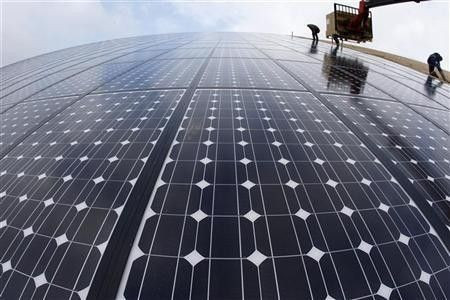Sunny report on solar exports

The Obama administration has an ambitious goal of doubling U.S. exports over the next five years and creating two million U.S. jobs in the process.
We're on track to meet it, President Obama said recently, noting exports were up 18 percent over the last year.
The U.S. solar power industry is doing its part, according to a study released today.
The study, U.S. Solar Energy Trade Assessment 2010, commissioned by the Solar Energy Industries Association, or SEIA, and conducted by GTM Research, found the U.S. solar industry is a net exporter of solar energy products, with net exports totaling $723 million in 2009.
The report also found that the solar industry created $3.6 billion in direct value to the global economy. Of that sum, $2.6 billion stayed within the U.S.
The largest export item of the solar industry was polysilicon, the primary component of most photovoltaic cells. Germany, Japan and China were the biggest export destinations.
China and Mexico were the largest importers to the U.S. for the industry.
The report noted that the solar industry is more balanced than the overall economy. The U.S. had a trade deficit of $374 billion in 2009.
Solar is a global industry. The U.S. imports and exports product from every continent. But in addition to being a major net exporter of solar energy products, the industry is creating significant wealth in the United States and jobs in all 50 states, said Rhone Resch, president and CEO of SEIA.
Resch said the solar industry is seeing investments in manufacturing in areas of the nation that were hit hard by the recession, notably in Tennessee, Michigan and Ohio.
But Resch said the industry is concerned that it does not have enough support from federal economic policies.
Even modest federal policies like expanding the 48c manufacturing tax credit can help the U.S. solar industry remain one of the few sectors of our economy that is a net exporter, while creating tens of thousands of jobs, Resch said.
The 48c tax credit, established by the American Recovery and Reinvestment Act, has met its cap. Sen. Debbie Stabenow, D-MI, is attempting to attached a renewal of the credit to the Middle Class Tax Relief Act of 2010, which is the bill containing the tax cut/UI extension compromise reached by the Obama administration and Republican leadership.
The Senate is currently debating the compromise bill and could vote on it as early as today.
The solar industry, and other alternative energy industries, also support an extension of the Treasury Grant Program, due to expire at year's end. The TGP allows the owner of a commercial alternative energy business to receive a 30 percent grant, in lieu of taking the industry tax credit.
This funding has supported the industry during these lean times and, since industry leaders expect the tax equity finance market to stay anemic for at least the next two years, renewal of the program becomes crucial.
Senators Maria Cantwell, D-WA, Dianne Feinstein, D-CA and other lawmakers have attached a one-year renewal of the TGP to the compromise bill.
© Copyright IBTimes 2024. All rights reserved.




















